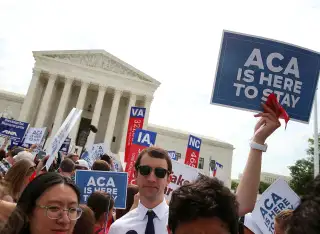The Real Reason the Gig Economy Is Suddenly Booming

The freelance economy is thriving like never before, and a new survey finds it's an unintended consequence of the Affordable Care Act.
Companies say the cost of complying with the Affordable Care Act is pushing them to rely more heavily on freelance workers, and freelancers are working harder, too. When executive development firm Future Workplace and online work platform Field Nation surveyed 600 human resources professionals and nearly 1,000 freelance workers, they found that nearly three-quarters of companies plan to hire more freelancers this year as a way to avoid higher healthcare costs they face as a result of the Affordable Care Act.
The increased demand for freelance talent is a mixed blessing for these workers, who value being able to manage their own time but miss out on job stability and benefits. At the same time the trend benefits companies, which are seeking more flexible work teams and the ability to scale staff levels up and down quickly. As the gig economy expands, companies are finding that they can tap specific skills and build blended workforces — although they do still struggle with concerns about workers' availability and technical capabilities.
According to an American Health Policy Institute survey of 100 large companies with workforces of greater than 10,000, the Affordable Care Act is estimated to cost these firms between $4,800 and $5,900 per employee. The non-partisan group's research also found that the new healthcare policy could collectively cost companies as much as $186 billion over 10 years' time.
Read next: The Highest Paying Jobs for Freelancers
In part to avoid these costs, companies are relying more on freelance or contract workers. The Future Workplace/Field Nation survey found that three-quarters of companies will increase their freelancer head count, and that many will do so at a significant rate: Almost half of HR respondents expect to ramp up their freelance hiring by 30% or more.
Today’s freelancers are experienced and educated; about a quarter have two-year degrees, nearly as many have four-year degrees and 10% have graduate degrees. They’re also not new to the workforce: 90% have had full-time jobs in the past, about half are between 35 and 51 years old and a third have been freelancing for more than seven years. About half are married and fewer than 5% say their families are unsupportive of their freelance careers.
Calculator: Save now vs. save later
Freelancing is a full-time gig for a surprising number of these people: Although about 45% spend fewer than 20 hours a week freelancing, 27% log between 30 and 49 hours a week and roughly 8% work 60 or more hours a week.
Roughly 30% earn less than $10,000 annually from their freelance gigs, but about a third serve seven or more clients each month and nearly one in five earn $50,000 or more a year freelancing, with nearly 4% earning six figures or more annually.
Read next: Answer These 5 Questions Before You Go Freelance
These generally aren’t short-term gigs either, the survey found. More than half have freelance relationships that extend for longer than 10 months. When asked what skills make them good at freelancing, the vast majority said self-management, problem solving, critical thinking and verbal communication were most important traits. A significant number, though, said they needed to undergo technology training, improve their sales or financial skills to be successful as a freelancer.
The biggest attraction of the freelance lifestyle for many is having more control over their time, and only 10% think they won’t be freelancing five years from now. The biggest drawbacks were the often-unpredictable income and the uncertainty of finding new projects on an ongoing basis, along with a lack of health benefits.
The Affordable Care Act has had an impact on freelancers as well as employers. Although roughly three in five say the healthcare law hasn’t impacted their freelance careers, about 21% are working more hours now, and the same number have increased either their number of clients or projects.
On the question of whether or not the shift has been positive or negative for today’s freelancers, the results are mixed. Nearly three in 10 say they’re making more money now than when they worked full-time, while 47% say they make less on their own.
Read next: Why Politicians Better Start Listening to Freelancers
About a third of respondents say freelancing is their ideal working situation, while 26% would like to have a full-time job and 41% aspire to own a small business, and 30% have a full-time job and are moonlighting on the side for extra money.
For many freelancers today, the flexibility and freedom appear to be worthwhile trade-offs for some uncertainty and lack of a traditional corporate support structure.